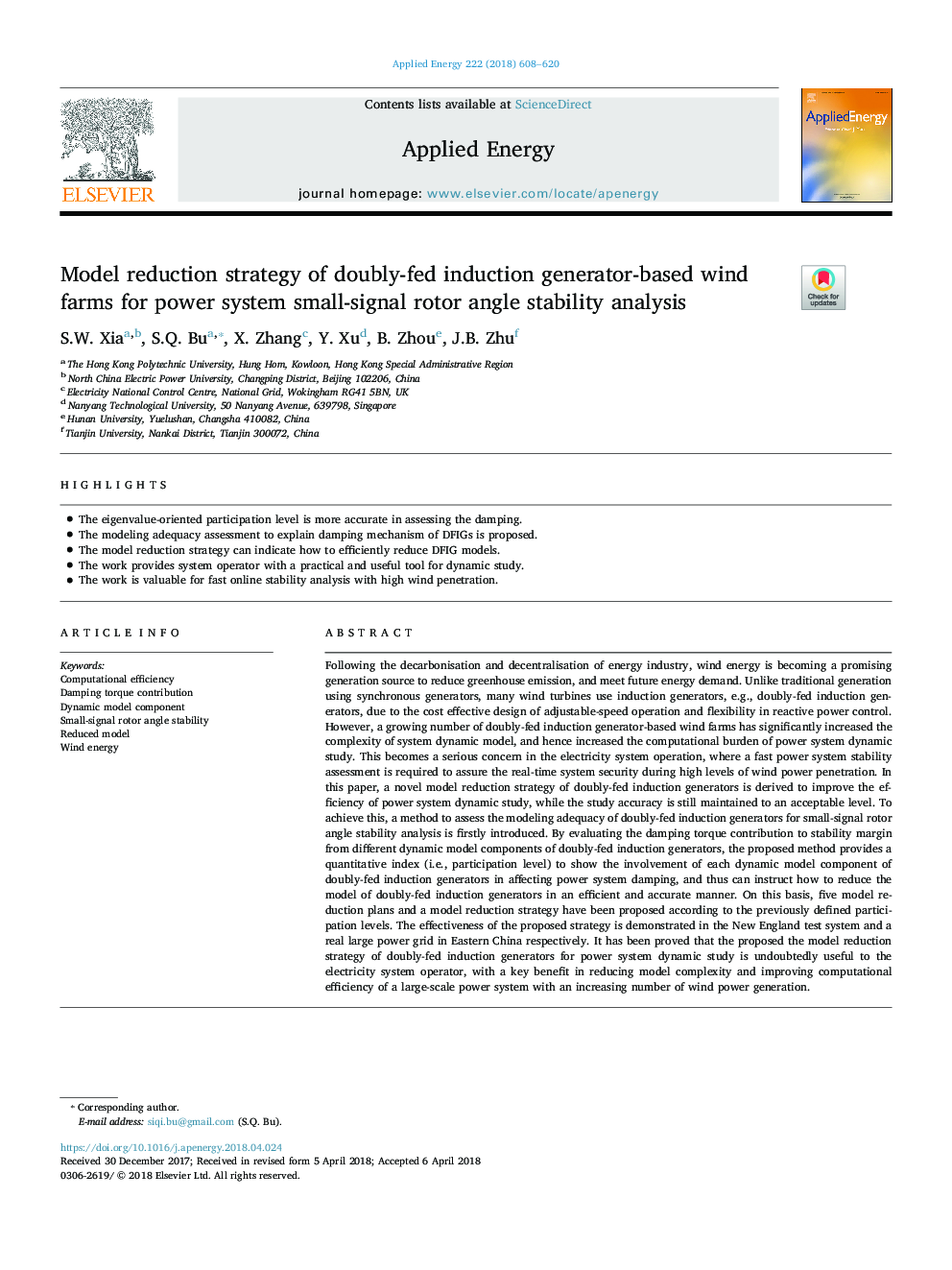| کد مقاله | کد نشریه | سال انتشار | مقاله انگلیسی | نسخه تمام متن |
|---|---|---|---|---|
| 6680218 | 1428068 | 2018 | 13 صفحه PDF | دانلود رایگان |
عنوان انگلیسی مقاله ISI
Model reduction strategy of doubly-fed induction generator-based wind farms for power system small-signal rotor angle stability analysis
ترجمه فارسی عنوان
استراتژی کاهش وزن مدل مجهز به بادگیرهای مبتنی بر القایی دوگانه برای تحلیل پایداری زاویه ای روتور کوچک سیستم قدرت
دانلود مقاله + سفارش ترجمه
دانلود مقاله ISI انگلیسی
رایگان برای ایرانیان
کلمات کلیدی
کارایی محاسباتی، کمک هزینه گشتاور لغزنده جزء مدل پویا پایداری زاویه روتور کوچک سیگنال، مدل کاهش یافته، انرژی باد،
ترجمه چکیده
پس از اتمام کربن زدایی و عدم تمرکز انرژی صنعت، انرژی باد تبدیل به یک منبع تولید کننده امیدوار کننده برای کاهش انتشار گازهای گلخانه ای و تقاضای انرژی آینده است. بر خلاف نسل سنتی با استفاده از ژنراتورهای همزمان، بسیاری از توربین های بادی از ژنراتورهای القایی استفاده می کنند، به عنوان مثال، ژنراتور القایی با دوام تغذیه، به دلیل طراحی هزینه های عملیاتی قابل تنظیم سرعت و انعطاف پذیری در کنترل قدرت راکتیو. با این حال، تعداد روزافزون مزارع بادی مبتنی بر ژنراتور مبتنی بر دوبرابر، پیچیدگی سیستم دینامیکی سیستم را افزایش داده و به همین ترتیب بار محاسباتی مطالعات پویای سیستم قدرت را افزایش داده است. این نگرانی جدی در عملکرد سیستم برق است، که در آن یک ارزیابی پایداری سیستم قدرت سریع برای اطمینان از امنیت سیستم در زمان واقعی در سطح بالای نفوذ انرژی باد ضروری است. در این مقاله، یک استراتژی کاهش نوآوری مدل ژنراتورهای القایی دوگانه برای بهبود کارایی سیستم دینامیکی سیستم قدرت، در حالی که دقت مطالعه هنوز به سطح قابل قبول است. برای دستیابی به این هدف، یک روش برای ارزیابی کفایت مدل سازی ژنراتورهای القایی دوگانه برای نشان دادن پایداری زاویه روتور کوچک، ابتدا معرفی شده است. با ارزیابی سهم گشتاور بارگیری در حاشیه ثبات از مولفه های پویای مختلف موتورهای القایی دوگانه تغذیه، روش پیشنهادی یک شاخص کمی (یعنی سطح مشارکت) را برای نشان دادن دخالت هر مولفه مدل پویا از ژنراتورهای القایی دوگانه در تأثیر ماندگاری سیستم قدرت و در نتیجه می تواند چگونگی کاهش کارایی و دقت مدل ژنراتور القایی با دوبار تغذیه را توضیح دهد. بر این اساس، پنج برنامه کاهش مدل و یک استراتژی کاهش مدل مطابق با سطوح مشارکت قبلا مشخص شده است. اثربخشی استراتژی پیشنهادی در سیستم آزمون نیوا انگلند و یک شبکه برق واقعی واقع در شرق چین نشان داده شده است. ثابت شده است که پیشنهاد شده استراتژی کاهش وزن مدل ژنراتور القایی با تغذیه دوگانه برای مطالعه پویای سیستم برق، بدون شک مفید برای اپراتور سیستم برق است، با یک مزیت کلیدی در کاهش پیچیدگی مدل و بهبود کارایی محاسباتی یک سیستم قدرت در مقیاس بزرگ با افزایش تعداد تولید برق باد.
موضوعات مرتبط
مهندسی و علوم پایه
مهندسی انرژی
مهندسی انرژی و فناوری های برق
چکیده انگلیسی
Following the decarbonisation and decentralisation of energy industry, wind energy is becoming a promising generation source to reduce greenhouse emission, and meet future energy demand. Unlike traditional generation using synchronous generators, many wind turbines use induction generators, e.g., doubly-fed induction generators, due to the cost effective design of adjustable-speed operation and flexibility in reactive power control. However, a growing number of doubly-fed induction generator-based wind farms has significantly increased the complexity of system dynamic model, and hence increased the computational burden of power system dynamic study. This becomes a serious concern in the electricity system operation, where a fast power system stability assessment is required to assure the real-time system security during high levels of wind power penetration. In this paper, a novel model reduction strategy of doubly-fed induction generators is derived to improve the efficiency of power system dynamic study, while the study accuracy is still maintained to an acceptable level. To achieve this, a method to assess the modeling adequacy of doubly-fed induction generators for small-signal rotor angle stability analysis is firstly introduced. By evaluating the damping torque contribution to stability margin from different dynamic model components of doubly-fed induction generators, the proposed method provides a quantitative index (i.e., participation level) to show the involvement of each dynamic model component of doubly-fed induction generators in affecting power system damping, and thus can instruct how to reduce the model of doubly-fed induction generators in an efficient and accurate manner. On this basis, five model reduction plans and a model reduction strategy have been proposed according to the previously defined participation levels. The effectiveness of the proposed strategy is demonstrated in the New England test system and a real large power grid in Eastern China respectively. It has been proved that the proposed the model reduction strategy of doubly-fed induction generators for power system dynamic study is undoubtedly useful to the electricity system operator, with a key benefit in reducing model complexity and improving computational efficiency of a large-scale power system with an increasing number of wind power generation.
ناشر
Database: Elsevier - ScienceDirect (ساینس دایرکت)
Journal: Applied Energy - Volume 222, 15 July 2018, Pages 608-620
Journal: Applied Energy - Volume 222, 15 July 2018, Pages 608-620
نویسندگان
S.W. Xia, S.Q. Bu, X. Zhang, Y. Xu, B. Zhou, J.B. Zhu,
